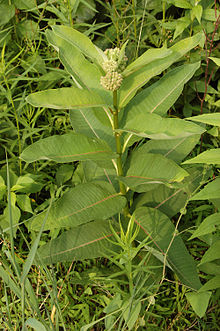 |
 |
(from Wikipedia) |
(from Wikipedia) |
Common Milkweed - Asclepias syriaca
Food:
"Young shoots, unopened flower buds and immature seed pods were eaten raw, boiled, or fried in oil (with or without batter). Milkweed was often added to soups and stews to thicken broth and tenderize meat. It was usually necessary to first cover the plants with boiling water, return the water to a boil, discard the water and repeat this process 2-3 times to reduce bitterness. Young plants (4-6") could be used like asparagus and young firm pods (3/4 - 1 1/4" long) like okra. The sweet buds and flowers were boiled down to make a thick syrup or brown sugar. They were also made into preserves. Milkweed seeds were occasionally eaten." (Kershaw 146)
"Raw or cooked. Salads, soups, omelets, stir-fries, kebabs. Even if the outer pod hull is too dry late in the season, the inner parts may still be moist and edible. In the spring, young milkweed shoots are also edible, but are difficult to identify and not recommended for beginners." (Seebeck 53)
"In Taos, its young leaves or immature pods are cooked like green beans and added to meat dishes, to increase their palatability, or to increase the size of the dish should an unexpected by welcome visitor arrive." (Curtin 92)
"A tea made from plant parts was a remedy for stomach troubles at Acoma and Laguna and as a treatment for fevers and coronary problems at San Juan. Other Tewa Indians also prepared a tea of ground milkweed roots to help chest pain victims. At Isleta the people used to inhale powdered leaves and stems to relieve a stuffy nose." (Dunmire and Tierney 197)
Medicine:
"The milky sap was traditionally used to treat skin problems. It was applied to cuts and burns and to a wide range of infections and irritations, including warts, moles, ringworm, poison-ivy rash, measles, corns and calluses. The plant tips were boiled to make a wash for treating blindness. The powdered roots were boiled to make medicinal teas for use as a sedative and as a treatment for stomachaches and asthma. Fresh roots were boiled to make teas for treating bowel problems, kidney problems, water retention, rheumatism, intestinal worms, asthma and venereal disease and for use as a temporary contraceptive. Seeds were boiled to make a solution for drawing poison from snake bites, or they were powdered and added to salves for treating sores." (Kershaw 146)
"The Tewa women take an infusion of the entire plant for sore breasts, and decoctions of the milkweed are given to the mothers if they have faulty lactation." (Curtin 92)
"Stimulates both urine and perspiration, softens bronchial mucus, dilates bronchials, and encourages expectoration. For a diuretic, Milkweed acts to increase the volume and solids of the urine and will aid in chronic kidney weakness typified by a slight nonspecific ache in the middle back, most noticeable in the morning or after drinking alcohol." (Moore 106-7)
Other Uses:
"Dried juice from broken stems provided chewing gum. The milky juice leaves a stain that can persist for days or weeks, and it was sometimes used to temporarily brand livestock. The seed silk was used to snuff pillows, mattresses and comforters and was even woven (with other fibers) into cloth." (Kershaw 146)
"The pods are gathered for spinning when about two thirds ripe." (Curtin 93)
"Fibers, called bast, from the stems of milkweed have been identified in prehistoric textiles associated with our area. One of the earliest ethnobotanical researchers in New Mexico found that Tewa-speaking people of the Rio Grande were still making string and rope from these fibers. However, at Zuni it was the silky seed fibers that once were spun on a hand-held wooden spindle into yarn and woven into fabric, especially by dancers." (Dunmire and Tierney 197)